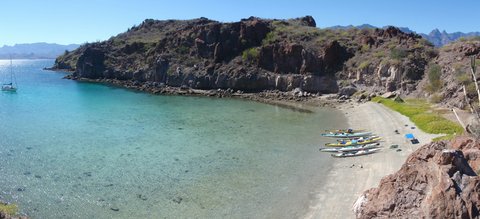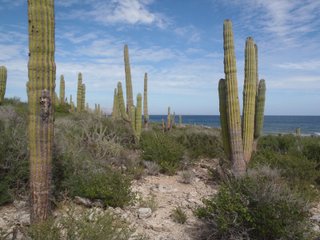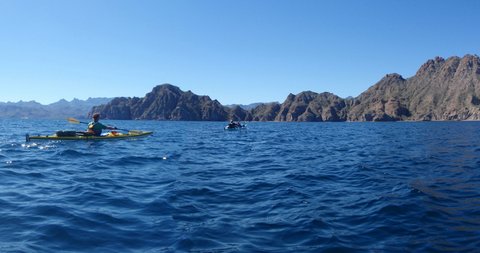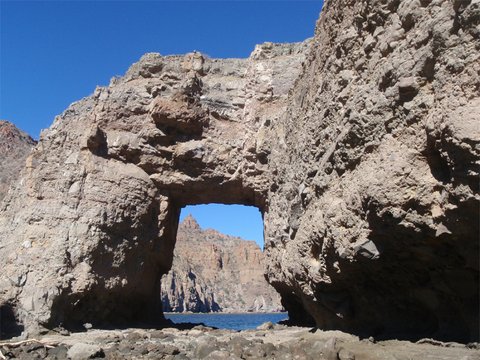by Ken Chorel
The idea of kayaking in the Sea of Cortez had been rattling around in my head since long before I ever “set foot” in a kayak. I don’t recall any more how the idea first formed, but for some reason, Baja has always been a destination I associated with kayaking. Finally, after far too long a wait, the opportunity presented itself, and now I’ve been twice in the span of two years.
My brother, Bruce, and I had first gone in November 2010. (I was originally to be the third wheel along with Bruce and his partner Michelle, but she was recovering from an injury and didn’t feel ready to sleep on the ground just yet, so Bruce and I went.) That time, we were two among ten guests, with two local guides, Sergio and Marcos of Tofino Expeditions. That trip was a roaring success, and we couldn’t have asked for better guides or a better group of people to paddle with, for our introduction to Baja paddling.
For the return visit this past November, Bruce and Michelle recruited another brother, Jim, as well as myself, so there were four of us this time, plus any others who might have signed on with the outfitter.
Bruce, Michelle, and Jim live in Alberta, so we met in Los Angeles for one night before continuing on to Loreto, Mexico. Loreto is a friendly village of about 14,000 people, roughly one third of the way up from the tip of the Baja Peninsula, and it is the gateway to the Parque Nacional Bahia de Loreto, a marine National Park that was created in 1996 to protect aquatic life from the commercial fishing operations that had depleted fish stocks. The park encompasses about 2066 square kilometres of the bay, and there are five major islands in the park that are suitable for kayak camping.
At the brief orientation session at the hotel, we reconnected with Sergio and Marcos, who would again be our guides, and met the other paddler who would be joining us on this trip. Afterward, we were left to transfer our gear to the drybags the outfitter had supplied, and then head out for some further exploration of the town.
On launch day, our guides picked us up at the Hacienda and after a brief stop at their storage unit to dole out snorkel gear, wetsuits, etc., we were off on the half-hour drive to launch at a beach just south of Puerto Escondido. After loading up the kayaks with our personal gear, and distributing the kitchen cargo and drinking water among them, we were off. There is no running water on any of the islands in the Parque, so we had to bring the entire weeks supply of fresh water along with us. The 10-litre dromedary bags packed nicely into the points of the bow and stern, with another behind the seat, and one under my knees. Add to that the sack of fruit-juice boxes I was assigned to haul, and my boat was riding pretty low in the water as we set off.
The wind was still blowing strong as we launched, and the channel between the peninsula and Isla Carmen was all whitecaps, so Sergio and Marcos kept the group in close to shore as we made our way toward the point. After a short paddle of only a little over 2 kilometres, we pulled in to a small beach on the lee side of the point, for lunch. Sergio and Marcos fixed the first of what would be a succession of delicious lunches, while we explored the point. After lunch, Sergio announced that we would make camp here for the night. The wind had not let up, and they were leery of taking the group through the 7-kilometre crossing to Carmen, in those conditions.

As it turned out, it was a lucky break that we hadn’t left the mainland that first day. As happy hour approached, we learned that the guides had neglected to pack the tequila. It seems Sergio thought that Marcos packed it, and Marcos though that Sergio packed it. Marcos jumped into his kayak and paddled off to get some. Darkness soon set in, so we gathered up some of the beach debris that was left by the recent hurricane, and started a campfire to help the tequila … uh, I mean Marcos … find his way back. Marcos returned to a round of cheers, and a delayed happy hour commenced, with margaritas all around.
The next morning was still windy, but not so windy as the day before. The waves in the channel were now only about 1 metre. After a generous breakfast, we packed up and set off. We crossed first to the northern tip of Isla Danzante, where we pulled briefly into a sheltered cove, to adjust some rudder pedals, then continued on toward Isla Carmen. As we approached the southwest shore of Carmen, we came into somewhat more sheltered water and had a leisurely paddle around Punta Baja, the southernmost tip of the island. We pulled in for lunch at the white sand beach just around the point. By now the sun was scorching, but fortunately there was a pair of palm trees to provide shade. If any of us had had a hammock along, this would have been the perfect spot to hang it. Alas, no hammock.

The next morning we were spared the chore of breaking camp. We geared up quickly and easily for a day-paddle farther up the coast. As we paddled north, the typical red rocks of most of the shoreline gave way to white limestone. We soon came across a cave in the base of the cliff, easily big enough to accommodate all 5 kayaks at once, each turning and manoeuvring without interfering with the others. A little farther on, we reached our lunch stop for the day, Arroyo Blanco, a white sand beach framed on each side by white cliffs. A little snorkelling before lunch, and then a relaxing siesta after lunch, and soon it was time to head back to camp.
The next morning, we packed up and headed south again, toward Isla Danzante. The channel crossing was quite calm this day, and as we crossed we could see a pod of dolphins splashing and spouting off in the distance. They submerged for a while, but then reappeared about 50 metres ahead of us. They swam by within 3 metres of Bruce and Michelle’s boat, and then meandered among and between the rest of our boats. It seemed as if they were checking each of us out individually. We could hear them spouting as they continued to circle around behind us for a few minutes and when they had satisfied their curiosity, they moved on.
Our first stop on Danzante was the pebble beach of Bahia Honda. Again, we had time to explore while Sergio and Marcos prepared lunch. The distinctive feature of this stop was the massive stone arch separating Bahia Honda from the next bay to the north.
Our campsite for the next two nights was at El Arroyo, just a short paddle around the south tip of the island from Bahia Honda. Set in a narrow valley with hiking trails winding back up into the hills, this was my favourite campsite. Lots of sandy tent pads set back among clearings in the brush, and plenty of exploring both along the beach and up into the valley. Sergio warned us about scorpions here, and he was right. As I adjusted my tent, a 4-inch specimen scuttled past, just beyond my toes. I had no idea scorpions could move so fast.
Our final day-paddle of the trip took us up the west side of Danzante to Honeymoon Cove, site of my earlier rudder-pedal adjustment. There were several trails to explore around this area and at the high point; those who felt so inclined could get a cell phone signal.
Upon our return to camp, Bruce and I went out to practise some rolls and assisted rescues, and about the time we came back to the beach, Sergio was dishing out some fresh scallop sashimi. He had been snorkelling and decided to bring some scallop back in with him. What a delicious, and unexpected, treat. And as we were finishing that up, Marcos caught an octopus. This one took a little more preparation than the scallop, but next up we had octopus salsa on tortilla chips.


